Triodia bunglensis (S.W.L. Jacobs) M. Lazarides. Austral. Syst. Bot. 10: 418–419
(1997).
Classification. (GPWG 2001) : Subfamily
Chloridoideae. Triodeae.
Basionym and/or
Replacement Name: Plectrachne
bunglensis S.W.L. Jacobs, Nuytsia 8(2): 222 (1992).
Type of Basionym or
Protologue Information: Western Australia: Northern Province; Bungle Bungle
Range, Lat. 17º27' S, Long. 128º25' E, 4.vi.1985., M.I. Blackwell BB60
(HT: PERTH).
Key references
(books and floras): [2002] D.Sharp & B.K.Simon, AusGrass, Grasses of
Australia.
Illustrations:
[2005] K.Mallet (ed.), Flora of Australia 44B: Poaceae 3 (Fig.
33J-M).
Habit.
Perennial. Culms 150 cm tall. Leaf-sheaths smooth or scaberulous, glabrous on
surface or hairy. Leaf-sheath auricles absent. Ligule a fringe of hairs, 3 mm
long. Leaf-blades straight or curved or flexuous, filiform, conduplicate, 12–30
cm long, 0.8 mm wide. Leaf-blade surface scabrous.
Inflorescence.
Inflorescence solid or compound, a raceme, a panicle. Panicle linear, 95–200 cm
long, 1.5–2 cm wide.
Spikelets.
Spikelets pedicelled. Fertile spikelets 1 or more flowered, with 1 fertile
floret (1–2), comprising 1–2 fertile floret(s), with diminished florets at the
apex, lanceolate, laterally compressed, 5–6 mm long.
Glumes.
Glumes similar, thinner than fertile lemma. Lower glume linear or lanceolate,
scarious, keeled, 1-keeled, 1–3 -nerved. Lower glume surface glabrous. Lower
glume apex muticous or awned. Upper glume linear or lanceolate, 4–7 mm long,
scarious, keeled, 1-keeled, 1 -nerved. Upper glume surface glabrous. Upper
glume apex entire or dentate or lobed, muticous or awned.
Florets.
Fertile lemma 2–3 mm long, without keel, 3 -nerved. Lemma surface glabrous or
indumented. Lemma apex lobed, awned, 3 -awned. Median (principal) awn 10–20 mm
long overall. Lateral lemma awns present. Palea apex entire or dentate.
Lodicules present. Anthers 3. Grain 1.6–2 mm long.
Continental
Distribution: Australasia.
Australian
Distribution: Western Australia.
Western Australia:
Dampier.
Notes.
Similar to P. bynoei in spikelet morphology, but differing chiefly in
its spiciform (not racemose) panicle, and usually larger lemmas with longer
awns.
Recorded
only from Bungle Bungle Natl Park, W.A. Found on sandstone cliffs, gorges and
domes; flowers recorded in Nov., Apr., June and July (spring, autumn and
winter); fruits recorded in Nov., Apr., June and July (spring, autumn and
winter).



